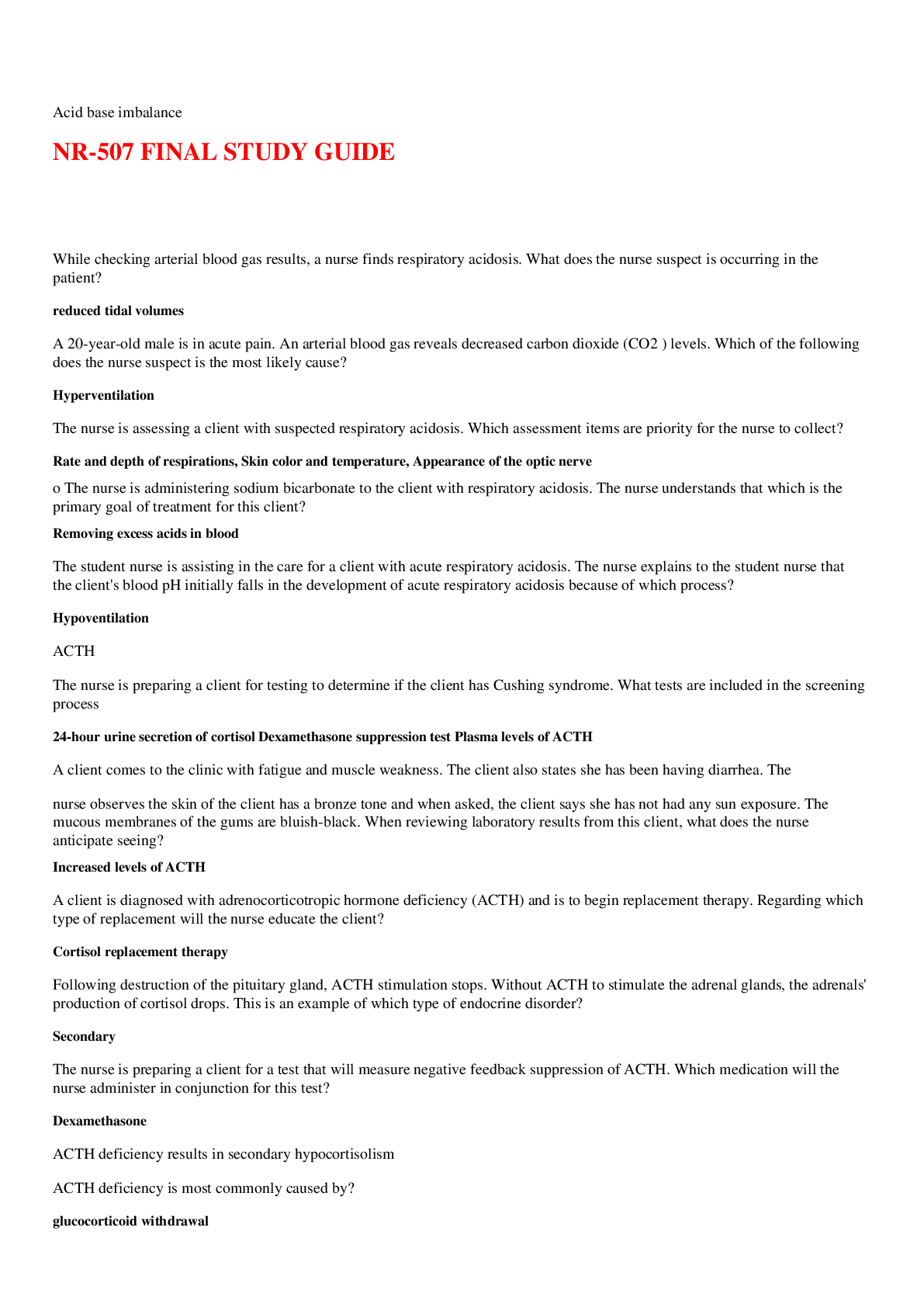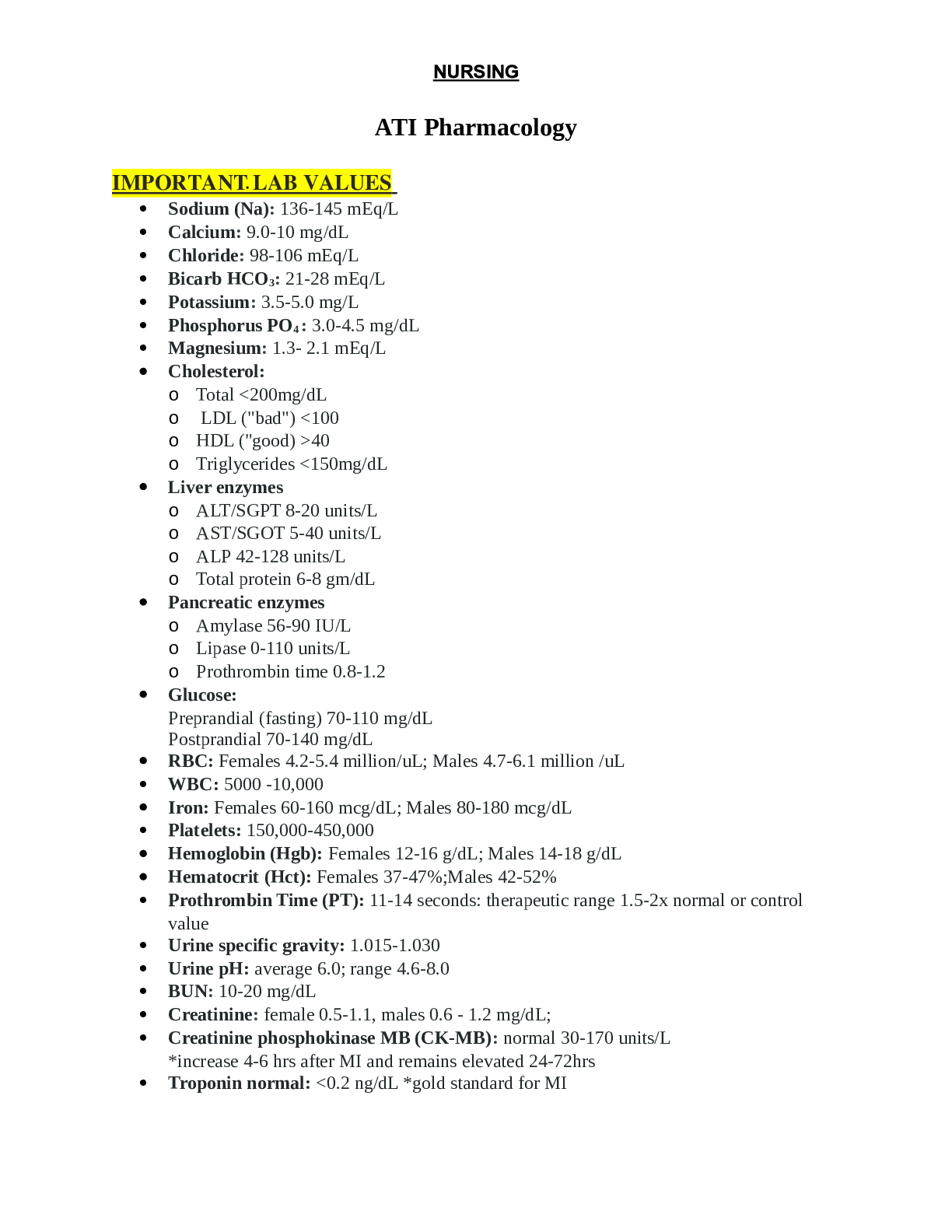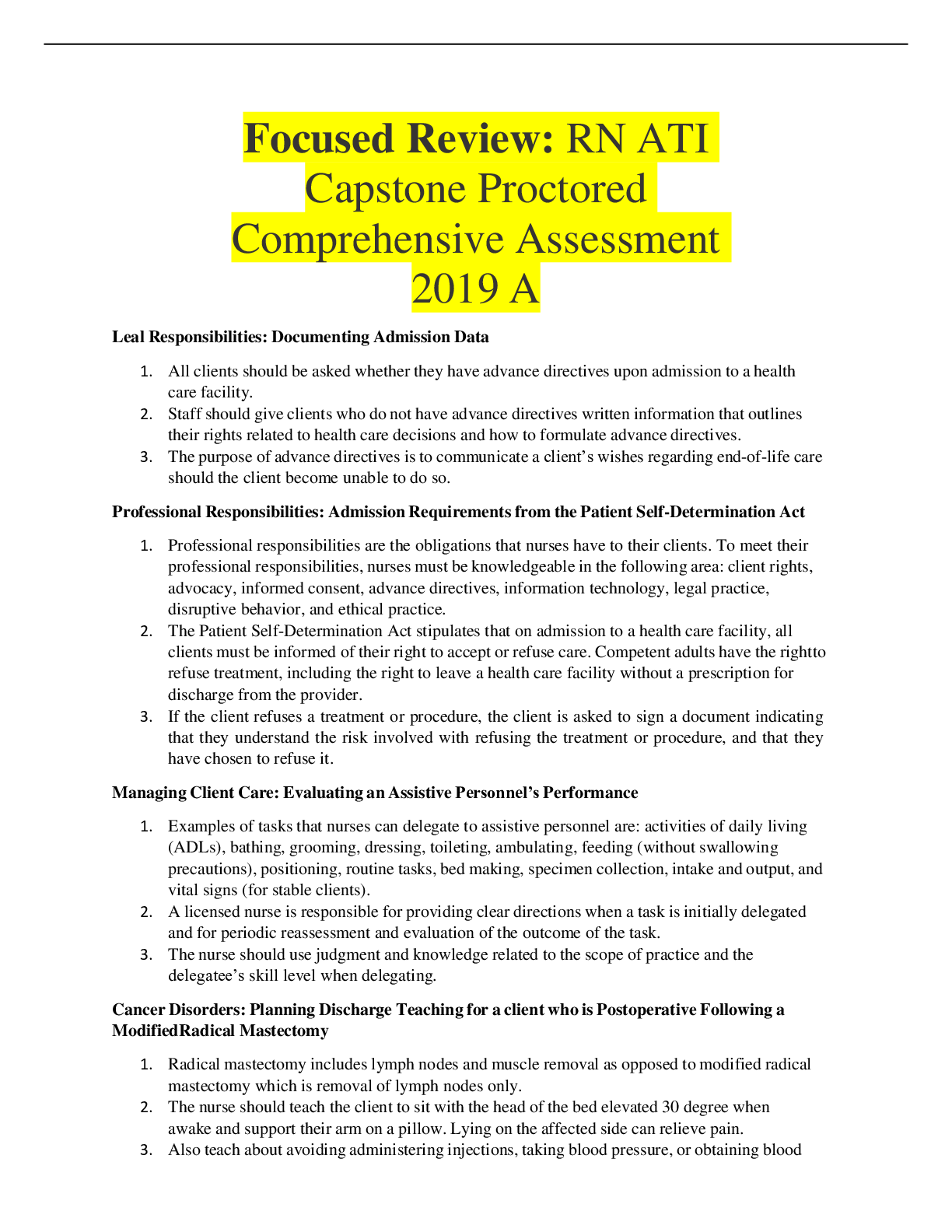*NURSING > EXAM REVIEW > West Coast University, Los Angeles - NURS 220Med Surg Exam 2 Review (All)
West Coast University, Los Angeles - NURS 220Med Surg Exam 2 Review
Document Content and Description Below
Medical Surgical Nursing Exam 2 – Review Look at pics for: Endocrine, Integumentary, and STDs Essay Marika-Evisceration Marika-Differences in Sprain and strain<- Know nursing assessments and int... erventions and S/S Marika or Steph E-Compartment Syndrome: Collaborative care, S/S, Treatment, Nursing Assessment/ intervention Steph E-Embolus thrombus(venous thromboembioli?)care,prevention, assessment http://www.atitesting.com/ati_next_gen/focusedreview/data/datacontext/rm_ams_pn_8_chp_ 69.pdf pg 778 Steph E-Crystalloid solution, Know all solutions Hyper/ Hypo tonic NW5 ….etc Steph-Hyper/Hypo Kalemia: Everything Hyperkalemia = serum potassium > 5.0 High serum potassium caused by – Massive intake; Impaired renal excretion; Shift from ICF to ECF Most common in renal failure, Also common in patients with massive cell destruction; Ex: – burn or crush injury, tumor lysis – rapid transfusion of stored, hemolyzed blood – catabolic states (e.g., severe infections) Causes: Certain drugs such as potassium-sparing diuretics e.g.spironolactone [Aldactone],triamterene [Dyrenium], angiotensin-converting enzyme (ACE) inhibitors (e.g., enalapril [Vasotec], lisinopril [Prinivil]), may contribute to the hyperkalemia. Manifestations: cardiac dysrhythmias, bradycardia, hypotension, may produce cardiac arrest; ECG: peaked T waves; hyperactive bowel sounds, diarrhea, paresthesias, muscle weakness NI: Force K from ECF to ICF by IV insulin or sodium bicarbonate; Reverse membrane effects of elevated ECF potassium by administering calcium gluconate IV; monitor for dysrhythmias. Patients with moderate hyperkalemia should additionally receive one of the treatments to force potassium into cells, usually IV insulin and glucose Hypokalemia = serum potassium < 3.5 caused by: Abnormal losses of K+ via the kidneys or gastrointestinal tract (losses of potassium secondary to diarrhea, laxative abuse, vomiting, and ileostomy drainage ) ;Magnesium deficiency –Metabolic alkalosis Manifestations: decreased level of consciousness; weakeness /paralysis; respiratory insufficiency; cardiac dysrhythmias, ECG changes: prominent U waves; shallow ineffective resperations; hypoactive bowel sounds, n/v, constipation; muscle aches, cramps, twitching, decreased deep tendon reflexes. NI: KCl supplements orally or IV - Should not exceed 10 to 20 mEq/hr – To prevent hyperkalemia and cardiac arrest; Continuous cardiac monitoring. Steph-Hyper/Hypo Natremia: Everything Normal serum sodium level is 135 – 145 mEq/L Hypernatremia = serum sodium > 145 Manifestations – Thirst, lethargy, agitation, seizures, and coma; Impaired LOC; Produced by clinical states – Central or nephrogenic diabetes insipidus; muscle twitching Potential complication: – Seizures and coma leading to irreversible brain damage NI: Treat underlying cause; If oral fluids cannot be ingested, IV solution of 5% dextrose in water or hypotonic saline; diuretics Serum Na levels must be reduced gradually to prevent too rapid a shift of water back into the cells. Overly rapid correction of hyperNa can result in cerebral edema. The goal of treatment for Na excess is to dilute the Na concentration with Na-free IV fluids, such as 5% dextrose in water, and to promote excretion of the excess Na by administering diuretics Hyponatremia = serum sodium < 135 Results from loss of sodium-containing fluids or from water excess. Manifestations – Confusion, restlessness, seizures; nausea, vomiting, muscle weakness, spasm or cramps. A common cause of hypoNa from water excess is inappropriate use of Na-free or hypotonic IV fluids. This may occur in patients: after surgery or major trauma, during administration of fluids in patients with renal failure, patients with psychiatric disorders associated with excessive water intake. Losses of Na-rich body fluids from the GI tract, kidney, or skin indirectly result in hypoNa NI: Caused by water excess – Fluid restriction is needed Severe symptoms (seizures) – Give small amount of IV hypertonic saline solution (3% NaCl); Abnormal fluid loss – Fluid replacement with sodium-containing solution Vasopressins – results in increased urine output without loss of electrolytes such as sodium and potassium. It should not be used in patients with hypovolemic hyponatremia ROME Respiratory Opposite – Alkalosis ↑ pH ↓ PaCO2 [Show More]
Last updated: 2 years ago
Preview 1 out of 14 pages

Buy this document to get the full access instantly
Instant Download Access after purchase
Buy NowInstant download
We Accept:

Reviews( 0 )
$8.00
Can't find what you want? Try our AI powered Search
Document information
Connected school, study & course
About the document
Uploaded On
Mar 27, 2021
Number of pages
14
Written in
Additional information
This document has been written for:
Uploaded
Mar 27, 2021
Downloads
0
Views
64














